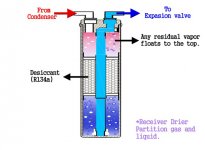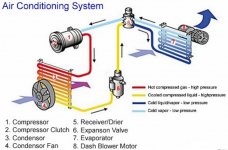Hi and you're welcome.

Just a copy / paste from another site for ease and I put the RockAuto links in for each.
1. COMPRESSOR
The most essential component of any air conditioning system is the compressor. The four main functions that your vehicle’s compressor carries out include:
Pressurizing the refrigerant to cool the air
Sensing temperature changes inside and outside your car
Monitoring and controlling temperature output
Moving air to the condenser
More Information for ACDELCO 1521532
2. CONDENSER
Your vehicle’s A/C condenser is usually located in the front of the radiator, giving it the nickname of the mini-radiator. When the compressor is pressurizing the refrigerant, the condenser works to reduce the temperature and pressure of hot gasses coming from the refrigerant. In addition, the condenser is also responsible for moving the cooled liquid refrigerant to the receiver/dryer or accumulator.
More Information for ACDELCO 1562899
3. RECEIVER/DRYER OR ACCUMULATOR
Whether or not you have receiver/dryer or accumulator depends on the model of your vehicle. A receiver/dryer is present in vehicles that have a thermal expansion valve. An accumulator, on the other hand, is found in vehicles that have an orifice tube. The receiver/dryer works to separate gas from liquid. The compressor can be ruined if any liquid gets in. That’s because a compressor isn’t designed for liquids, just gasses. This part also takes out moisture using a desiccant. Desiccants can be compared to the small, bead-filled packet you find in packaging for new electronics. Finally, there are also filters that protect the A/C system from contaminants.
The accumulator is responsible for monitoring and controlling the amount of refrigerant that goes into the evaporator. It also stores excess refrigerant, filters debris and removes moisture.
(The XLR appears to have the dryer included within the condenser)
4. THERMAL EXPANSION VALVE OR ORIFICE TUBE
As stated previously, cars with a thermal expansion valve utilize a receiver/dryer while a vehicle with an orifice tube utilizes an accumulator. Regardless, the Thermal Expansion Valve or Orifice Tube should be located between the condenser and evaporator. Together, they monitor the amount of pressure and temperature of your A/C system and calculate the exact amount of refrigerant that can safely go into the evaporator.
More Information for ACDELCO 1550696
More Information for FOUR SEASONS 39340 <--- this contradicts the paragraph above however in the event (due to distance) someone / something doesn't jive, hey, you can use it for a key chain.

5. EVAPORATOR
Another part that’s crucial if you want cold, refreshing air hitting your face is the evaporator. You’ll find this component right behind the dashboard. It’s in charge of cooling the air with the refrigerant before it is blown into the cabin of your vehicle.
(One would hopefully be able to avoid changing this...typically a very unpleasant task however I don't have experience with the XLR which may be better or [probably] worse.)
---
First off, I'd really hope you've had the system charge checked. If it's low it may work, just not very well. I did actually mean in the physical / exterior sense. The fins and such of the condenser need to be clean and clear so it can 'radiate' in exactly the same way your engine radiator does. We're flowing air through these two things to cool down the closed loop contents. Radiator doing it for the engine coolant, condenser doing it for the Freon (or equivalent) gas.
I would think that you would have heard squealing belts if something wasn't right with those. An AC compressor draws something like -5- horsepower from an engine, and that's a fairly significant 'ask' of a belt that is too loose. They usually slip and scream terribly.
It's not a new car and it's living in a place where I'd bet your A/C is on pretty much all the time. If the system is clean and properly charged and it's still not making nice frosty air, your compressor is most likely just getting tired. I couldn't blame it actually - that's hard work in a less than hospitable climate for sure.
All the other components mentioned are 'typically' changed. It's a costly job more often than not in labor so if you or someone else dives in up to their ankles, it's just a good plan to do it all and then you can set the A/C system mileage count back to zero with confidence. Note also that as the compressor has (probably) been wearing, all the little bits from it be they ever so small, are now somewhere within the closed loop. Some things you can't get in to clean, others...less costly to replace than clean.
Don't forget oil and o-rings (actually, your shop should have these handy), and if you haven't changed your cabin air filter, best to do that too along with checking as deep in that path as possible for further dust and debris. It's all about airflow!
Hope I got most everything for you - write back if I've missed.
Gord




 whala
whala




